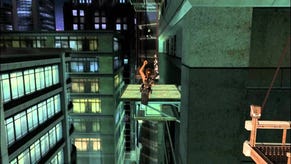Tomb Raider: Underworld
Shouting Lara, Lara, Lara, Lara.
Eidos Man skips forward to a later, drier part of the level. Now Lara's arse is walking through a series of interconnected doorways and corridors - "There's no dot-to-dot play path," he says. Again, we're in familiar territory; there are stone walls to climb, ledges to jump between, chains to shoot and switches to pull. But it all looks better than ever, thanks to some beautiful lighting effects and highly realistic textures. The way moisture runs down the walls is particularly impressive. It's all very quiet; Eidos Man says they deliberately chose to avoid sticking a soundtrack in here, instead allowing the noise of distant dripping water and Lara's lone footsteps echoing through the corridors to build atmosphere. Good choice.
The middle room of the structure is home to a huge Kraken. His tentacles extend throughout the surrounding corridors; they block access to key doors and switches, so Lara must find a way to get rid of him. He's so big bullets will just bounce off so it's a matter of using the environment, of working out what you need to change and how you must do it. More classic Tomb Raider, then.
However, the new "adrenaline moments" aren't quite so archetypal. They replace the quick-time events in Legend and Anniversary, where you had to hit a specified button at the right moment to save Lara in the middle of cut-scenes. "That was fun for a while," says Eidos Man, who clearly has very loose definitions of the words 'fun' and 'a while', "But we wanted to put control back into the player's hands, so we eliminated the need for a button press."
Instead these adrenaline moments occur at predetermined points in each level. An event will occur, and, as Lara's adrenaline kicks in, time and the camera will slow down. This gives you an extra second or two to move her out of harm's way. In the example we're shown, one of the Kraken's tentacles lashes out and whacks the platform Lara is standing on. The screen goes all blurry, everthing happens in slo-mo and Eidos Man manages to make Lara jump to safety before normal service is resumed.

Adrenaline moments do appear to be an improvement over Quick Time Events; no more incongruous cut-scenes and feeling like you're playing some kind of weird, rubbish rhythm-action game. But old-days Tomb Raider fans will recall some of the best, most memorable moments were when something completely unexpected happened, and only the most lightningy of reflexes would save you. Who could forget the giant stone ball rolling down the corridor, or the T-rex looming out of the darkness? True, nine times out of ten it all happened far too quickly and you were left breathless, as was Lara. But the shock was brilliant, and it wasn't such a hardship to go back and do it again.
Still. It's difficult to tell just how well the adrenaline moments will work without having played the game, and Crystal Dynamics certainly appears to be doing lots of other things right. Lara is more acrobatic and graceful than ever, the puzzles look clever and challenging, the environments are expansive, there's real atmosphere and it's visually stunning. As, of course, is Lara's arse. Let's hope that maybe, just maybe Tomb Raider: Underworld will start a new trend, and not just for arse over tits. Perhaps this time next year beautiful action-adventure games will be all the rage; no longer will shoot-the-monster-in-the-face titles dominate the catwalk. Who knows? Well, we all do, but it's nice to dream.
Tomb Raider: Underworld is due out on 21st November for PS3, 360, PC, Wii, PS2 and DS.




.png?width=291&height=164&fit=crop&quality=80&format=jpg&auto=webp)




.jpg?width=291&height=164&fit=crop&quality=80&format=jpg&auto=webp)
